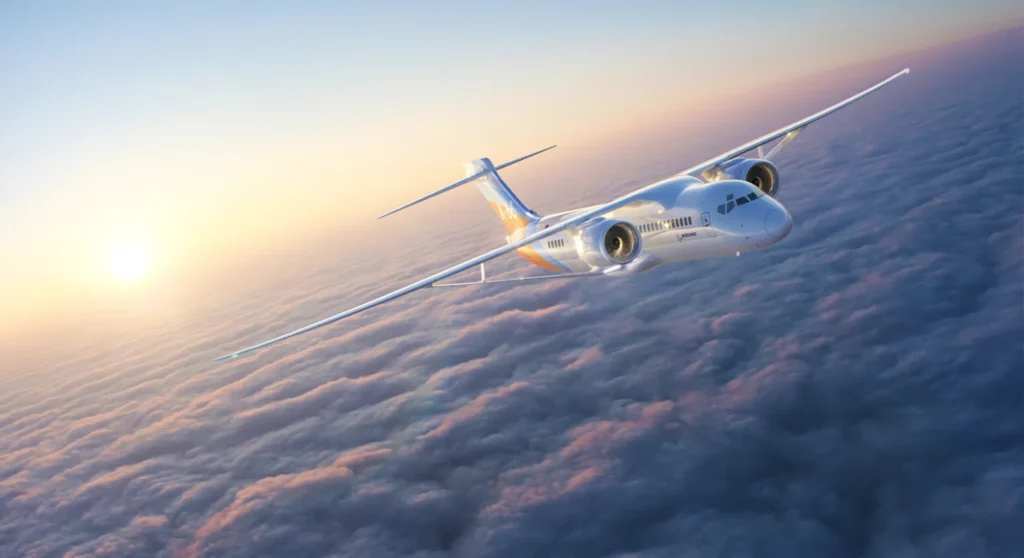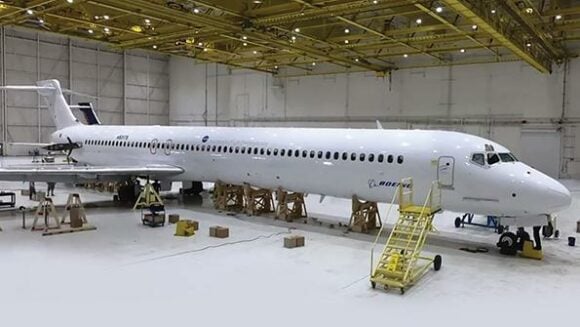
x 66a
The X-66A is NASA’s first experimental plane to help the U.S. achieve its net-zero aviation greenhouse gas emissions goal. The modification is taking place in Palmdale, California, and ground and flight testing is expected to start in 2028. The aircraft was named X-66A by the US Air Force.
NASA will fund $425 million via milestone payments, and Boeing and its partners will contribute $725 million.
Boeing ferried an MD-90 to Palmdale, and it is being modified to test the Transonic Truss-Braced Wing (TTBW) configuration as part of NASA’s Sustainable Flight Demonstrator project.

With ultrathin wings braced by struts with larger spans and higher aspect ratios, a TTBW and other technical advances could reduce fuel burn and emissions by up to 30%.

Boeing and NASA collaborated on the concept for over a decade through the Subsonic Ultra Green Aircraft Research (SUGAR) Program.
The MD-90 was equipped with IAE (Pratt & Whitney) V2500 engines, and the X-66A will use Pratt & Whitney GTF engines. The TTBW is optimized to fly at 0.8Mach, a typical airline’s “network speed.”
The 30% goal is an easy target. GTF fuel burn numbers among US airlines have already shown improvements of over 20%. This means the other technologies and the wing need to deliver 10%.
As Pratt & Whitney pushes for additional enhancements, exceeding the 30% goal is achievable. The project is helping NASA reach a goal of zero aviation emissions by 2050. “We at NASA are excited to be working with Boeing on the X-66A Sustainable Flight Demonstrator making critical contributions to accelerate aviation towards its 2050 net-zero greenhouse gas emission goal,” said Ed Waggoner, deputy associate administrator for programs in the NASA Aeronautics Research Mission Directorate.
A little ironic
Ironically, Boeing is using a McDonnell Douglas airplane as the base for the X-66A. The history of the two firms’ merger generated all sorts of commentary. In April 2023, NASA Administrator Bil Nelson described the X-66A as the precursor to replace the 737 MAX.
This irony aside, Boeing CEO Dave Calhoun said in November 2022 that there would be no new clean-sheet airplane this decade. Analysts’ reaction to this was not positive. In May 2023, at a media briefing before the Paris Air Show, Mr. Calhoun stated: “You have to be patient, you have to get ducks lined up, the technologies lined up and matured. Then whatever they cater to with respect to that next airplane, it’s got to be a big enough market to satisfy our investors. I really don’t want to get to that question until other things are ready.”
Some readers will nod, agreeing with the “satisfy our investors” statement, while others shake their heads in wonder. But let’s also put aside the well-trodden path and debate the focus on investors rather than customers.
Replacing the MAX
The critical issue is that the X-66A is essentially the testbed for replacing the 737 MAX. Airbus has signaled its thoughts about replacing the A320. Is the X-66A Boeing’s signal? If it is, Boeing is arguably ahead of Airbus because it has a physical experimental airplane. Mr. Calhoun’s statements then reflect these facts.
It is easy to argue that Boeing needs to “do something” about the MAX. The X-66A plausibly promises to deliver a step change in fuel burn improvements, with concomitant emission reductions.
Pratt & Whitney laid out its GTF technology plan in 2022 to provide at least 10% improved fuel burn by the decade’s end. The TTBW could house the CFM RISE engine, its high wing allowing space for the spinning blades. The TTBW potentially offers either engine. Either approach should offer double-digit improvements over current engines.
The TTBW offers high strength-to-weight ratios and benefits from the triangular structure. Airbus is using a different approach.
Boeing’s challenge is accelerating the X-66A program as it stabilizes the 737 MAX. In summary, even with the MAX challenges, Boeing has a promising replacement path.
Views: 125





“The 30% goal is an easy target. GTF fuel burn numbers among US airlines have already shown improvements of over 20%. This means the other technologies and the wing need to deliver 10%”.
The advancements of the GTF are already part of the todays State of the Art. The 30% goal should be beyond that which is already flying today on A320neo/737max, not compared to ceo/ng. So not such an easy target.